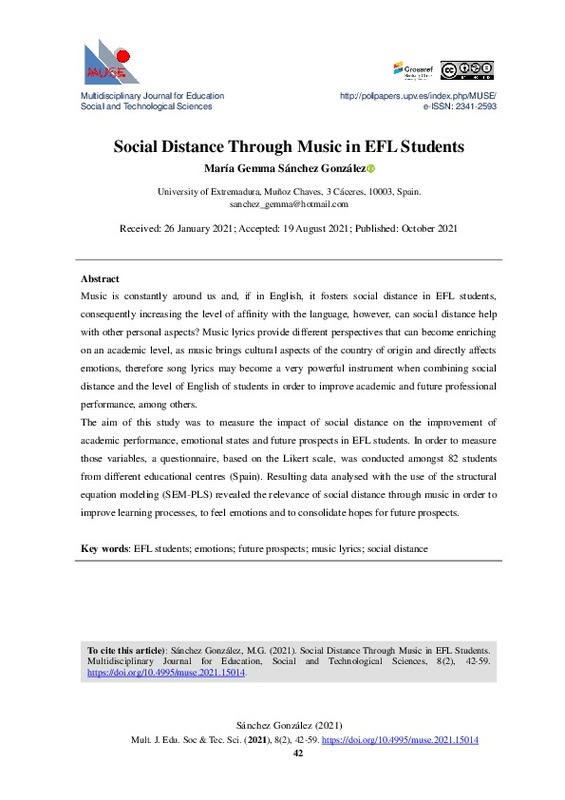Abbot, M. (2002). Using music to promote L2 learning among adult learners. Tesol journal, 11(1).
Alcaraz Varó, E. (2000). El inglés profesional y académico. Alianza Editorial.
Aragão, R. (2011). Beliefs and emotions in foreign language learning. Fuel and Energy Abstracts,39(3), 302-313. https://doi.org/10.1016/j.system.2011.07.003
[+]
Abbot, M. (2002). Using music to promote L2 learning among adult learners. Tesol journal, 11(1).
Alcaraz Varó, E. (2000). El inglés profesional y académico. Alianza Editorial.
Aragão, R. (2011). Beliefs and emotions in foreign language learning. Fuel and Energy Abstracts,39(3), 302-313. https://doi.org/10.1016/j.system.2011.07.003
Bogt, T., Mulder, J., Raaijmakers, Q.A.W., & Gabhainn, S.N. (2011). Moved by music: A typology of music listeners. Psychology of Music, 39(2), pp. 147-163. https://doi.org/10.1177/0305735610370223
Chin, W.W. (1998). The Partial Least Squares Approach to Structural Equation Modeling, In Modern Methods for Business Research, Marcoulides GA [ed]. Lawrence Erlbaum Associates: Mahwah N. J., 295-336.
Cooper, D.R., & Schindler, P.S. (2006). Business Research Methods (9th edition). McGraw-Hill.
Creswell, J.W., & Clark, V.L.P. (2017). Designing and conducting mixed methods research. Sage Publications.
Do, S.L., & Schallert, D.L. (2004). Emotions and classroom talk: Toward a model of the role of affect in students' experiences of classroom ciscussions. Journal of Educational Psychology, 96(4), pp. 619-634. https://doi.org/10.1037/0022-0663.96.4.619
Fedorenko, E. (2014). The role of domain-general cognitive control in language comprehension. Frontiers in Psychology, 5, p. 335. https://doi.org/10.3389/fpsyg.2014.00335
Flowerdew, J., & Peacock, M. (2001). Research perspectives on English for academic purposes. Cambridge University Press. https://doi.org/10.1017/CBO9781139524766
Fonseca-Mora, M.C. (2000). Foreign language acquisition and melody singing. Elt Journal, 54(2), 146-152. https://doi.org/10.1093/elt/54.2.146
Fornell, C., & Larcker, D.F. (1981). Evaluating structural equation models with unobservable variables and measurement error. Journal of Marketing Research, 18(1), 39-50. https://doi.org/10.2307/3151312
Fuller, A. (2015). Vocational education. International encyclopedia of the social & behavioral sciences (2nd Ed), 232-238. Elsevier. https://doi.org/10.1016/B978-0-08-097086-8.92091-9
Gardner, R.C., & Lambert, W.E. (1972). Attitudes and motivation in second language learning. Newbury House Publishers.
González Davies, M., & Celaya Villanueva, M.L. (1992). New teachers in a new education system: A Guide book for the Reforma. PPU.
Graddol, D. (1997). The future of English? British Council.
Henseler, J., Ringle, C.M., & Sarstedt, M. (2015). A new criterion for assessing discriminant validity in variance-based structural equation modeling. Journal of the Academy of Marketing Science, 43(1), 115-135. https://doi.org/10.1007/s11747-014-0403-8
Izard, C.E. (2002). Translating emotion theory and research into preventive interventions. Psychological Bulletin, 128(5), 796-824. https://doi.org/10.1037/0033-2909.128.5.796
Kachru, B.B., & Nelson, C.L. (2001). World Englishes. In A. Burns & C. Coffin (Eds.). Analysing English in a global context, 9-25. Routledge.
Krashen, S.D. (2003). Explorations in language acquisition and use. Heinemann.
Levitin, D.J. (2006). This is your brain on music: The science of a human obsession. Dutton/Penguin Books.
Macdonald, R., Kreutz, G., & Mitchell, L. (2012). What is music, health, and wellbeing and why is it important? Music, health, and wellbeing. Oxford Scholarship online. https://doi.org/10.1093/acprof:oso/9780199586974.003.0001
McLean, A.C. (1980). Destroying the teacher: the need for a learner-centred teaching. E.T.Forum, 28:3, 16-19.
Ménard, M., Richard, P., Hamdi, H., Daucé, B., & Yamaguchi, T. (2015). Emotion recognition based on heart rate and skin conductance. In Proceedings of the 2nd international conference on physiological computing systems, vol. 1: PhyCS, 26-32. https://doi.org/10.5220/0005241100260032
Nicolás, G., & Azorín, C. (2013). Música y valores. Una relación educativa ineludible. Música y educación: Revista trimestral de pedagogía musical, ISSN 0214-4786, Año nº 26, Nº 93, 16-25.
Niittylahti, S., Annala, J., & Mäkinen, M. (2019). Student engagement at the beginning of vocational studies. Nordic journal of vocational education and training, Vol.9, n.1, 21-42. https://doi.org/10.3384/njvet.2242-458X.199121
North, A.C., & Hargreaves, D.J. (1997). Music and consumer behaviour. In D.J. Hargreaves & A.C. North (Eds.), The social psychology of music, 268-289. Oxford University Press.
Pekrun, R., & Perry, R.P. (2014). Control-value theory of achievement emotions. In R. Pekrun & L. Linnenbrink-Garcia (Eds.), International handbook of emotions in education, 120-141. Routledge/Taylor & Francis Group. https://doi.org/10.4324/9780203148211
Punset, E. (2012). Una Mochila para el universo. Ediciones Destino.
Richards, J.C., Platt, J., & Platt, H. (1992). Dictionary of language teaching and applied linguistics. Longman.
Ringle, C.M., Wende, S., & Becker, J.M. (2015). SmartPLS 3. SmartPLS GmbH, Boenningstedt. http://www.smartpls.com
Sam, D.L, & Berry, J.W. (2010). Acculturation: When individuals and groups of different cultural backgrounds meet. Perspectives on Psychological Science, 5(4), 472-481. https://doi.org/10.1177/1745691610373075
Sánchez González, M.G. (2020). Adolescents and values portrayed in music nowadays. Multidisciplinary Journal for Education Social and Technological Sciences, v. 7, 2, 45-60. https://doi.org/10.4995/muse.2020.14001
Schumann, J. (1994). Where is cognition? Emotion and cognition in second language acquisition. In Studies in Second Language Acquisition, vol. 16, Issue 2, 231-242. Cambridge University Press. https://doi.org/10.1017/S0272263100012894
Shoaib, A., & Dörnyei, Z. (2004). Affect in lifelong learning: Exploring L2 motivation as a dynamic process. In P. Benson, & D. Nunan (Eds.), Learners' stories, 23-41. Cambridge University Press.
Sloboda, J.A., & Juslin, P.N. (2001). Handbook of music and emotion: Theory, research, applications, 605-642. Oxford University Press.
Tarrant, M, North A.C., & Hargreaves, D.J. (2000). English and American adolescents' reasons for listening to music. Psychology of Music, 28(2), 166-173. https://doi.org/10.1177/0305735600282005
[-]









